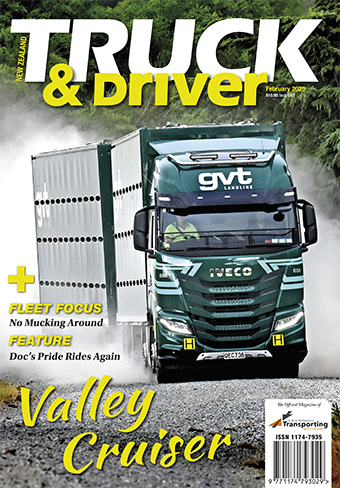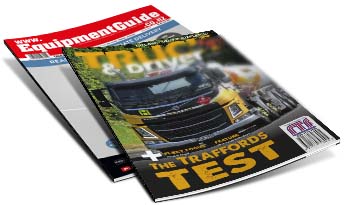Double Coin Imaging Awards


Trans West transformations
Double Coin Imaging Awards
It's a trucking operation that's been around on the Coast for 60 years. It's just that it's had a handful of different owners, three different colour schemes….and two different names in that time.
Trans West Freighters started out in Greymouth in 1958, the name first registered by Peter Gurr and Barry Hurley, its trucks bearing a cream and brown livery.
The name stayed the same for around four decades…with a colour scheme that was also little changed – with a red stripe added and the cream sometimes supplemented (or replaced) with white.
By 1986, TWF's West Coast owners were sharing the company with Nelson-based TNL and Northern Southland Transport – each group with a 33% shareholding.
But a year after the Transpac collapse in 1987 (which involved TNL), TWF became 100% owned by Northern Southland – and started a period of rapid growth.
The fleet numbers jumped from a handful of trucks in '86, to 28 just two years later…and 42 by 1995 – many of them Mercedes-Benz models.
It's a trucking operation that's been around on the Coast for 60 years. It's just that it's had a handful of different owners, three different colour schemes….and two different names in that time.
Trans West Freighters started out in Greymouth in 1958, the name first registered by Peter Gurr and Barry Hurley, its trucks bearing a cream and brown livery.
The name stayed the same for around four decades…with a colour scheme that was also little changed – with a red stripe added and the cream sometimes supplemented (or replaced) with white.
By 1986, TWF's West Coast owners were sharing the company with Nelson-based TNL and Northern Southland Transport – each group with a 33% shareholding.
But a year after the Transpac collapse in 1987 (which involved TNL), TWF became 100% owned by Northern Southland – and started a period of rapid growth.
The fleet numbers jumped from a handful of trucks in '86, to 28 just two years later…and 42 by 1995 – many of them Mercedes-Benz models.
In this period, TWF became renowned in the industry for its innovative ways of dealing with a difficult environment – like stock units with crates designed precisely to just fit under a heap of low-clearance bridges….
And, most famously, its practice of running B-train freight units across Arthurs Pass, beating the 13-metre length restrictions on the Otira Gorge zig-zag by having the tractor unit drop off the rear trailer, tackling the Gorge, parking the front trailer...
Then doubling back and picking up the rear trailer, returning…and then re-assembling the B-train. Eventually, TWF even got to the point of leaving a tractor unit at one end of the restricted route to save unhooking the B-train tractor. Even with the to-ing and fro-ing it saved 68kms or so each way, compared to running via the Lewis Pass.
Then, around the start of the new millennium, the fleet was rebranded – the TWF name and colour scheme disappearing, its trucks instead taking on the Northern Southland Transport name and its brown and cream livery.
Then, seven years ago, the Trans West Freighters name made a comeback, albeit with a brand-new colour scheme – blue and white base colours, separated by a red stripe.
It's a radical departure from its historic colours – so how come? Simple: In the wake of Northern Southland's West Coast freight business being sold to Toll New Zealand, its Canterbury/Westland livestock and bulk operations were also sold – to Methven-based Philip Wareing Ltd, which has blue and white base colours…with gold stripes.
Thus, says PWL's Mark Wareing, it achieved two things – a distinctly different look and branding to the colours of former owner Northern Southland…and the return of an important name in the Coast's history.
It's this colour scheme, which currently adorns seven trucks, that earns Trans West Freighters the status as this month's finalist in the PPG Transport Imaging Awards.
It's a livery that's shown off to great effect on TWF's two latest additions – a pair of identical Kenworth K200 Aerodyne HPMV livestock units, powered by 615-horsepower Cummins X15 engines and driven by Dylan Pupich and Mike Johnson.
The colour scheme, which also currently features on two DAF CF85 tippers and three Mercedes-Benz Actros units – two on livestock and one tipper – was something of a no-brainer in terms of its base colours, according to Mark Wareing.
"It was easy deciding on the Wareings blue to cover up the Northern Southland brown." And the red stripe served two purposes – in that it's a nice nod back to the red stripe on the old brown and cream TWF colour scheme….
"And we wanted it to break the white and the blue up a bit."
He reckons jokingly that the colour scheme was decided "in a family argument one day – the 'board meeting' we have every morning and every night."
In terms of the look of the trucks – as distinct from the actual colours used – "we didn't want to make it a million miles away from where it currently was. So people still recognised the phone number and the drivers. And the brand."
They were at pains to ensure that the Trans West Freighters and TWF signwriting looks very similar to the company's original branding.
So, as Wareing says: "The old name's come back – hopefully stronger than it ever was." Although the branding is the same, technically the company name is slightly different – it's now Trans West Freighters (2011) Ltd.
There was some discussion initially about having the trucks showing off "a bit more silver."
That was dropped – but Mark for one is delighted with how the new Kenworths bring some "bling," in the form of their alloy wheels and bumpers, stainless steel mesh grilles and chrome grille surrounds: "They really do stand out."
Timaru Signs came up with the graphics for the most recent trucks added – the DAFs and the Kenworths. That includes subtle differences to the detailed livery – retaining the red shadow under the TWF logo on the front of the Kenworth Aerodyne sleeper cabs…
But simplifying the front-of-cab branding to Trans West – dropping the 'Freighters' – and adding a pale blue shadow. There's also red and white pin-striping around the headlights and the bottom of the cab and a new treatment of the Trans West Freighters signwriting on the doors.
Where the company Mercs saw the white drop down to keep the 'Trans West Freighters' signwriting all on a white background, the red stripe now runs straight – with 'Trans West' on the white and 'Freighters' on the blue.
Wareing says that PWL's signwriting used to be done inhouse, "but it got too big for us – so we took it outside.
"They usually do a couple of mockups and my brother, me and my father sit around and say 'we'll change that....we'll have this' and do whatever."
Public and customer response to the latest form of this historic Greymouth-based operation's branding has been good, says Mark Wareing: "A lot of West Coasters like the TWF brand – and they like the colour scheme."




 + EQUIPMENT GUIDE - FREE
+ EQUIPMENT GUIDE - FREE
